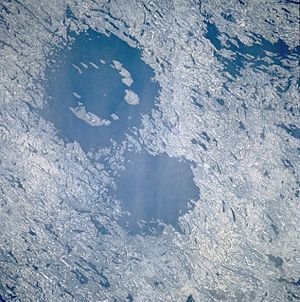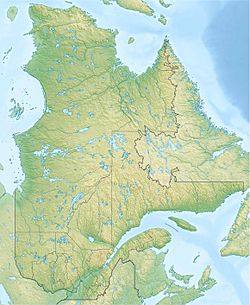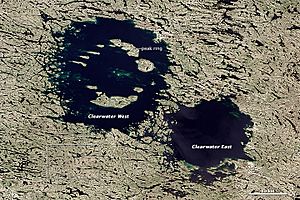Clearwater Lakes facts for kids
Quick facts for kids Clearwater LakesLac à l'Eau Claire |
|
|---|---|

Clearwater Lakes as seen from a Space Shuttle (North is top right)
|
|
| Location | Baie-d'Hudson, Kativik, Quebec |
| Coordinates | 56°08′N 74°18′W / 56.133°N 74.300°W |
| Type | Impact crater lake |
| Primary outflows | Clearwater River |
| Basin countries | Canada |
| Surface area | 1,383 km2 (534 sq mi) |
| Max. depth | 178 m (584 ft) |
| Surface elevation | 241 m (791 ft) |
The Clearwater Lakes are a pair of special lakes in Quebec, Canada. They are close to Hudson Bay. Their official name in French is Lac Wiyâshâkimî. In the Cree language, they are called Wiyâšâkamî, which means "clear water." The Inuit people call them Allait Qasigialingat.
These lakes are actually one big body of water. Many islands form a "dotted line" between the eastern and western parts. The name "Clearwater" comes from how incredibly clear their water is. There are actually 25 lakes with this name in Quebec! These are the biggest and most northern ones. They are also the second largest natural lake in Quebec, after Lake Mistassini.
In 1896, a scientist named Albert Peter Low explored the area. He noted how clear and deep the icy waters were. This helped explain why the Cree people gave the lakes their descriptive name.
Contents
Lakes Formed by Space Rocks
The Clearwater Lakes sit in two round dips in the ground. These dips were made by ancient impact craters. An impact crater is a big hole left when a space rock crashes into Earth. The eastern crater is 26 km (16 mi) wide. The western crater is 36 km (22 mi) wide.
Scientists once thought both craters formed at the same time. This was about 290 million years ago, during the Permian period. They thought maybe two space rocks, flying together, hit Earth at the same moment. This idea is called the "doublet impact crater theory." It was even suggested that these space rocks might have been like a binary asteroid. This means two asteroids orbiting each other, like a tiny moon around a planet.
Both Clearwater East and Clearwater West are "complex craters." This means they have a raised area in the middle, like a bump. This bump is called a central peak. It forms when the ground bounces back up after a huge impact. The central peak of Clearwater East is covered by lake water and dirt. But scientists have used special tools and drilled into the lake floor to confirm it's there.
Ancient Impacts: Ordovician Period
Newer studies show that the two lakes were actually formed at different times. Scientists looked at rocks from the craters. They found that Clearwater East was formed about 460 to 470 million years ago. This was during the Ordovician period, a very long time ago!
Ancient Impacts: Permian Period
Clearwater West was formed later, about 286 million years ago. This was during the Permian period. Scientists can tell the impacts were different. They found different clues in the rocks. These clues show that the space rocks that hit each spot were not the same.
Local Weather and Plants
Because the Clearwater Lakes are so big, they can change the weather nearby. This is called a micro climate. It's like a tiny weather system just for that area. This special climate affects the plants that grow there.
Around the edges of the lake, you'll find plants typical of boreal forests. These are forests with lots of pine and spruce trees. But on the islands in the western part of the lake, the plants are different. They are more like plants found in the arctic. This makes the islands a special "arctic island" right in the middle of a different climate zone!
Tursujuq National Park
A huge area around the Clearwater Lakes is now a national park. This park is called Tursujuq National Park. It also includes Richmond Gulf and Iberville Lake. The park is 15,549 km2 (6,004 sq mi) big. It is Quebec's largest national park. It officially opened in 2012.
See also
 In Spanish: Lagos Clearwater para niños
In Spanish: Lagos Clearwater para niños



